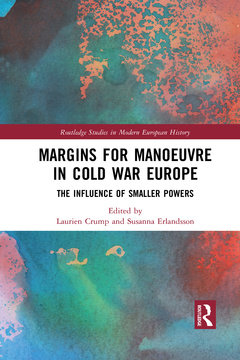Margins for Manoeuvre in Cold War Europe The Influence of Smaller Powers Routledge Studies in Modern European History Series
Coordonnateurs : Crump Laurien, Erlandsson Susanna

The Cold War is conventionally regarded as a superpower conflict that dominated the shape of international relations between World War II and the fall of the Berlin Wall. Smaller powers had to adapt to a role as pawns in a strategic game of the superpowers, its course beyond their control. This edited volume offers a fresh interpretation of twentieth-century smaller European powers ? East?West, neutral and non-aligned ? and argues that their position vis-à-vis the superpowers often provided them with an opportunity rather than merely representing a constraint. Analysing the margins for manoeuvre of these smaller powers, the volume covers a wide array of themes, ranging from cultural to economic issues, energy to diplomacy and Bulgaria to Belgium. Given its holistic and nuanced intervention in studies of the Cold War, this book will be instrumental for students of history, international relations and political science.
Introduction: Smaller Powers in Cold War Europe;
Part I: Manoeuvring through Multilateralism;
1. Challenging the Superpower Straightjacket (1965–1975): Multilateralism as an Instrument of Smaller Powers;
2.Multilateralism as Small Power Strategy (1950–1952): The Netherlands, the Benelux and the European Defence Community;
3.Small States, Alliances and the Margins for Manoeuvre in the Cold War: Sweden, Norway and the CSCE;
4. A Critical Ally (1949–1977): The Dutch Social Democrats, Spain and NATO;
Part II: The Margins of Superpower Rule;
5. Manoeuvring into the Soviet Market: Polish and Finnish Eastern Trade Practices during the Cold War;
6. The Imperative of Opening to the West and the Impact of the 1968 Crisis: Bulgaria’s Cooperation with Denmark and West Germany in the 1960s;
7. Americanising the Belgian Civilising Mission (1941–1961): The Belgian Information Center in New York and the Campaign to cast the Belgian Civilising Mission as part of the Point IV Programme;
8. A Gas Giant in a Small State’s Clothes (1981–1982): A Political Economy Analysis of the Dutch Margins for Manoeuvre During the Urengoy Pipeline Crisis;
Part III: Identity as an Instrument;
9.Neutrality as an Instrument of Small State Manoeuvring and the Globalisation of Neutrality in the Cold War;
10, Denuclearisation and Regional Cooperation: Romania’s Tactical Approaches to Escaping Bloc Rigidities;
11. Transitional Margins to Re-Join the West: Spain’s Dual Strategy of Democratisation and Europeanisation;
12. ‘At last, our voice is heard in the world’: Greece and the Six Nation Initiative during the Euromissile Crisis;
Conclusion: Shedding a New Light on Cold War Europe
Laurien Crump is Associate Professor in Contemporary European History at Utrecht University, the Netherlands. She has published widely on multilateral relations in the Cold War on both sides of the Iron Curtain, based on multi-archival research in eight European countries.
Susanna Erlandsson is Postdoctoral Researcher at the Department of History at Uppsala University, Sweden. She has published on Swedish and Dutch security policies in the 1940s, on personal trust in diplomatic relations and on the role of gender in diplomatic history.
Date de parution : 06-2021
15.6x23.4 cm
Date de parution : 12-2019
15.6x23.4 cm
Thèmes de Margins for Manoeuvre in Cold War Europe :
Mots-clés :
Cold War; Warsaw Pact; NATO; East Germany; Nicolae Ceaușescu; Securitate; Occupied Germany; Nuclear Threat; Nuclear Proliferation; Non-aligned Movement; Cold War research; Economic issues; Small NATO; Twentieth-century smaller European powers; NATO Accession; West Germany; FRG; State Secretary; NATO Member State; Vice Versa; NATO Member; European Security Conference; NATO Membership; EDC Treaty; NATO Country; Nuclear Disarmament; Marcelino Oreja; Den Uyl; MFT; Dutch Social Democrats; Smaller European Powers; Benelux Cooperation; Cold War Europe; Warsaw Pact Member; European Defence Community; Smaller Powers; MPT; Dutch Gas



